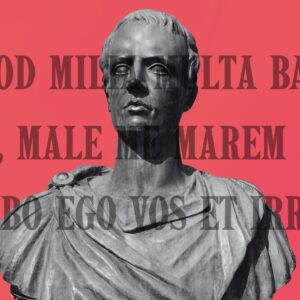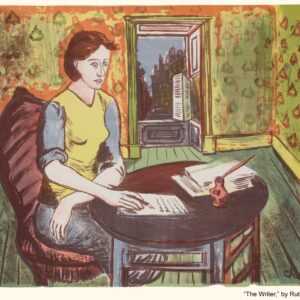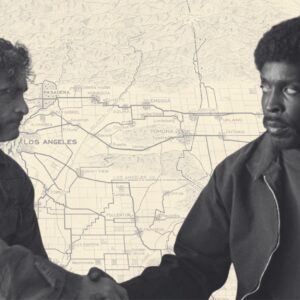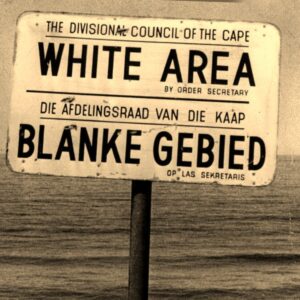
In Awe of Seabirds at the Edge of the World
Adam Nicolson Beholds the Poetic Beauty of the Guillemot
One day, on a steeply sloping grass shelf on the Shiant Isles in the Hebrides, two or three hundred feet above the surface of the Minch, the wide sleeve of sea between the mainland of Scotland and the Outer Isles, I was sitting with Emily Scragg, a young ornithologist who was spending her summer tracking guillemots and razorbills on their fishing trips out from the islands. The sea below us was alight with mid-morning, midsummer sunshine as if polished by it, and we were in shirt sleeves, watching the guillemots on the cliff, dark, handsome birds gathered and jostling there in their thousands. Emily had been putting a GPS tag on one of them, meticulously taped to the feathers on its back, hoping to track it as it foraged in the sea lochs of Lewis and Harris. She had done her work and the bird was back on the rock shelf from which she had picked it ten minutes before. She now had to wait 24 hours and the guillemot’s data would return.
As we sat there, watching the big roughened crozier-arms of the tide swirling a mile or more out from the headlands below us, a black-backed gull arrived, cruising, easy, sliding low and slow over the guillemot colony, looking for what it might find, and as its shadow crossed them the guillemots in a sudden scare-flight broke away from the cliff, hundreds of them in one dropping, momentous movement, shearing away and down towards the sea. From above, it looked like the rippling of a single wing, a feathered eruption, a dark and magnificent beating of life itself.
Why do you love birds? I asked Emily. Because they fly, she said. That act of release is what is marvelous about them, not as a single done thing but as something that happens again and again, every year, every day, every new life.
“Seabirds somehow cross the boundary between the matter-of-fact and the imagined. Theirs is the realm both of enlargement and of uncertainty, in which the nature of things is unreliable and in doubt.”
The Atlantic seabirds come to breed in places of unremitting hardness. Much of the coastline is a sort of quarry, brutal and intractable, but above it the birds float like beings from the otherworld. They are gravity-free creatures in a place where gravity seems to rule. Seamus Heaney, in one of his lectures as professor of poetry at Oxford, quoted the French philosopher and mystic Simone Weil in her collection of aphorisms on grace and transcendence, published after she had died. Weil was exploring the idea that possibility and openness were necessary parts of what was good—the generosity of risk—when she wrote these mind-changing words: “Obéissance à la pesanteur. Le plus grand péché.” Obedience to gravity. The greatest sin.
Seabirds never commit it and intuitively, pre-scientifically, we see something oceanic in them, the hint and intimation of another scale of existence, not as part of another, spiritual world, but as the most miraculous and in some ways troubling quality of the one we inhabit. The poets have always understood this. “I’ll be the Bonxie,” Hugh MacDiarmid wrote of the great skua, “that noble scua, / That infects a’other birds wi’ its qualms,” as if one only had to look at a skua to feel the subtlety and edginess of the life it leads.
Seabirds somehow cross the boundary between the matter-of-fact and the imagined. Theirs is the realm both of enlargement and of uncertainty, in which the nature of things is unreliable and in doubt. After both his parents had died within two years of each other in the mid-1980s, Seamus Heaney for a while left behind the poetry of rich and tangible substance and from “the earth earthy,” as Helen Vendler the Harvard critic has called it, quoting St Paul’s description of the nature of the first Adam, turned towards a poetry of half-presences and near-absences. Right at the center of his 1991 collection, which he called Seeing Things, are some “set questions for the ghost of W.B.”—his challenge to Yeats’s austere presence over his shoulder.
What came first, the seabird’s cry or the soul
Imagined in the dawn cold when it cried?
How habitable is perfected
form? And how inhabited the
windy light?
There are no answers, only questions and suggestions, but in that Platonic vision Heaney’s imagined soul-seabird is not only the great boundary-crosser, but linked to the emergence and genesis of things. The seabird’s cry comes from the beginning of the world.
The birds’ gothic beauty is beyond touching distance. Their status has long troubled the scholars of these fragmentary poems, but the point is surely their ambiguity. These are creatures of high latitudes and distant oceans. They thrive in the sub-polar seas. The farther from home we might feel ourselves to be, the more at home they are. That is their world and they are part of what we long for: beauty on the margins of understanding. “The hiding-places of my power,” Wordsworth wrote in The Prelude, “Seem open, I approach, and then they close.” But these birds are more alive than ever in the hiding-places of the north. They are as good imagined—or remembered—as seen, souls and yet not souls, otherness as a dimension of the real. Half-presences, rock-ricochets in their calling. Creatures of the spirit, drenched in ambiguity, half us, half not us, bodies crying in the world.
Science, for all that non-scientists disparage it, is dedicated to that urge towards the inward, and the astonishing findings of modern seabird scientists mean that a sense of wonder now emerges not from ignorance of the birds but from understanding them. In the last couple of decades I have pursued the seabirds across the Atlantic. I have sailed up the west coast of Ireland, to St Kilda, Orkney, Shetland, the Faeroes, Iceland and Norway. I have been to the eastern seaboard of Maine and to Newfoundland, to Ascension, the Falklands, South Georgia, the Canaries and the Azores. The source of this sometimes obsessive fascination with the ways and lives of the birds comes from an experience my father gave me when I was a boy: he first took me when I was eight to the big seabird colony on the Shiant Isles. They are a little cluster of Hebridean islands to which he had been going since he was a student in the 1930s. When he was 20 in 1937, his grandmother had left him some money and, entranced by the idea of remoteness and wildness, he had bought the islands, three small specks of grass and rock, each about a mile long, a total of 500 uninhabited acres, with one rat-ridden bothy, for £1,300.
He loved it there more than anywhere on earth. That was where he went, repeatedly and alone, when on leave from the war in North Africa and Italy. For years he had promised to take me. When at last the day came, after a long journey by train and bus through England and Scotland and then with Gaelic-speaking fishermen and shepherds on a rolling herring-boat across the Minch, I watched carefully as the islands slowly acquired form and contour in front of me. Their grey whale-backed outlines grew and ballooned into something substantial. Dark rocks, grassy slopes, a sheltered bay, the little white house, stony beaches. I had never seen this scale of things before: tall, cliffed, remote, fierce, beautiful, harsh and difficult but, for all that, dazzlingly and almost overwhelmingly thick with the swirl of existence, lichened, the rocks glowing saffron orange on that summer morning, the air and the sea around us filled with 300,000 birds, a pumping, raucous polymorphous multiversity in which everything was alive and nothing refined.
It was a vision of another world. We landed and picked our way among the colonies. Birds swept over us. We could sit by them and look them in the eye a yard away. Chicks peeped from among the boulders. Puffins growled deep in their burrows. As giant wheels of them turned in the air, their flight feathers rustled and hushed above us. A great black-backed gull swept down and grabbed one in mid-flight. Older victims, stripped of their meat, washed to and fro in the edges of the sea. Beauty and perfection, death, dissolution and life, suffering and triumph: it was all here.
__________________________________
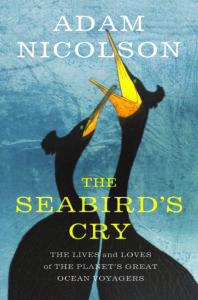
From the introduction to The Seabird’s Cry: The Lives and Loves of the Planet’s Great Ocean Voyagers. Used with permission of Henry Holt. Copyright © 2018 by Adam Nicolson.
Adam Nicolson
Adam Nicolson is a prize-winning writer of many books on history and nature, including Sea Room, the New York Times bestseller God's Secretaries, and the acclaimed Why Homer Matters. His most recent novel is The Seabird's Cry. He is winner of the Royal Society of Literature's Ondaatje Prize, the Somerset Maugham Award, the W. H. Heinemann Award, and the British Topography prize. He has written and presented many television series and lives on a farm in Sussex.















